Morning Venus Crosses Scorpius’ Claws, the Long Nights Moon for Yule, Spotty Jupiter, and a Christmas Critter!
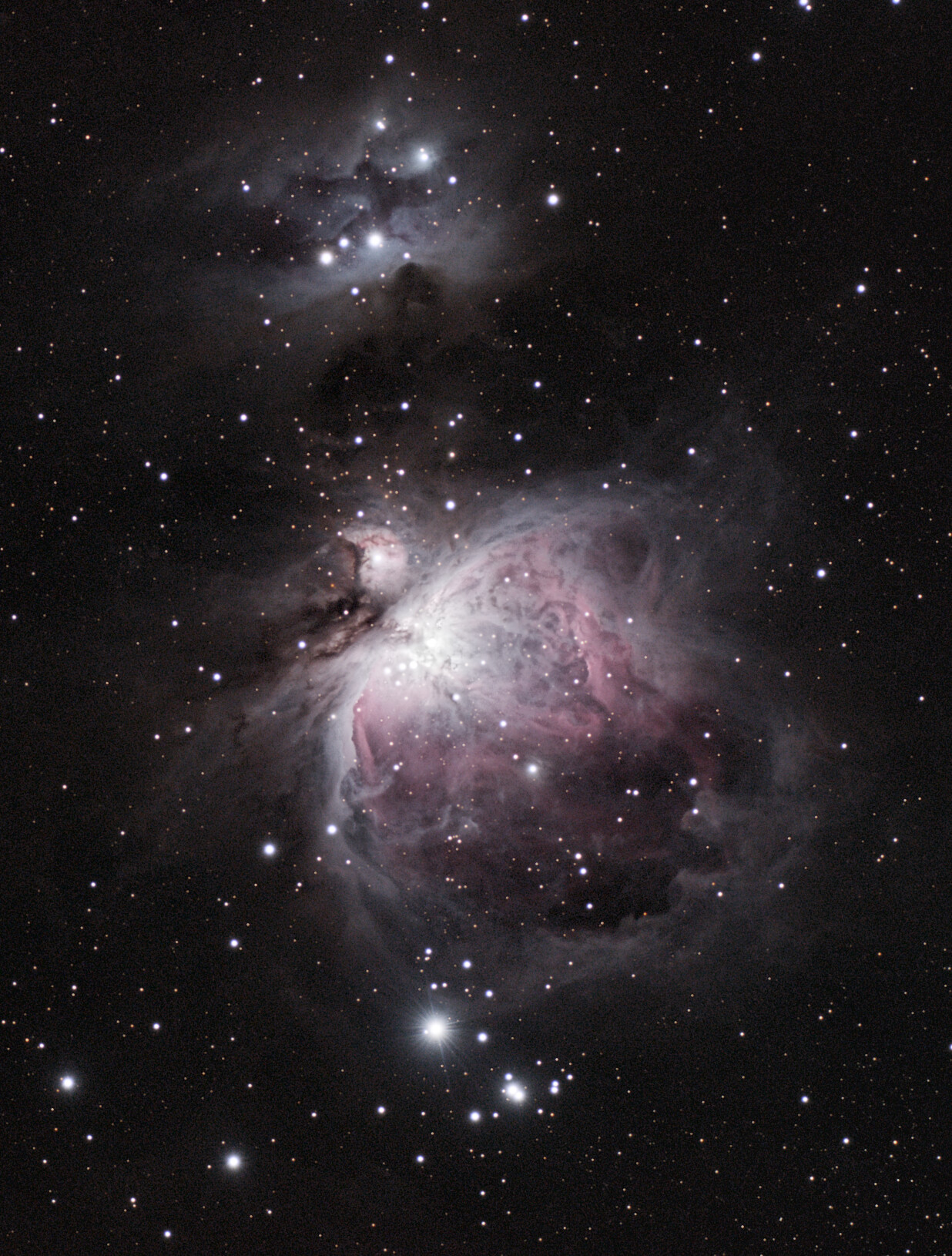
This magical image of the sword of Orion was captured and processed by my friend John Deans when he was in Bancroft, Ontario on February of 2021. All three patches of light from top to bottom are visible to unaided eyes below Orion’s three-starred belt. Binoculars and backyard telescopes will reveal the spectacular details in the big Orion Nebula at centre, including the clump of four stars of the Trapezium Cluster buried in its core.
Hello, Yuletide Stargazers!
Here are your Astronomy Skylights for the week of December 24th, 2023 by Chris Vaughan. Feel free to pass this along to your friends and send me your comments, questions, and suggested topics. You can also follow me on Twitter as @astrogeoguy! Unless otherwise noted, all times are expressed in Eastern Time. To subscribe to these emails please click this MailChimp link.
If you’d like me to bring my Digital Starlab portable inflatable planetarium to your school or other daytime or evening event, or deliver a session online, contact me through AstroGeo.ca, and we’ll tour the Universe, or the Earth’s interior, together! My book with John A. Read entitled 110 Things to See With a Telescope is a guide to viewing the deep sky objects in the Messier List – for both beginners and seasoned astronomers. DM me to order a signed copy!
The moon will be full and bright worldwide over Christmas this week, and extra high in the late night sky for observers in the northern hemisphere – but it will gradually leave evening. I point out a couple of interesting, but faint Yule-themed critters among the northern stars. Early risers can catch Venus crossing the scorpion’s “stolen” stars. In evening, Saturn and Jupiter continue to shine, with Jupiter sporting lots of spots – both red and black. Read on for your Skylights!
The Christmas Goose
The brightest star in Perseus (the Hero) is Mirfak or Alpha Persei (α Per). On the evenings surrounding Christmas every year, Perseus can be found climbing the eastern sky above the very bright star Capella and below the W-shaped stars of Cassiopeia (the Queen). Grab your binoculars! Mirfak’s golden light sparkles at the upper left (northwestern) edge of a large and loosely scattered cluster of about 100 hot, bright, blue-white B and A-class stars known as the Alpha Persei Moving Group, the Perseus OB Association, and Melotte 20. Those stars are siblings of Mirfak – born from the same molecular hydrogen cloud about 41 million years ago – and now travelling through the galaxy together with Mirfak. The open star cluster, which is sprinkled across 3 degrees of the sky, can be seen with unaided eyes, and looks wonderful in binoculars. In his book Binoculars Highlights, astronomer Gary Seronik suggested that the brightest stars in Mirfak’s cluster resemble a goose.
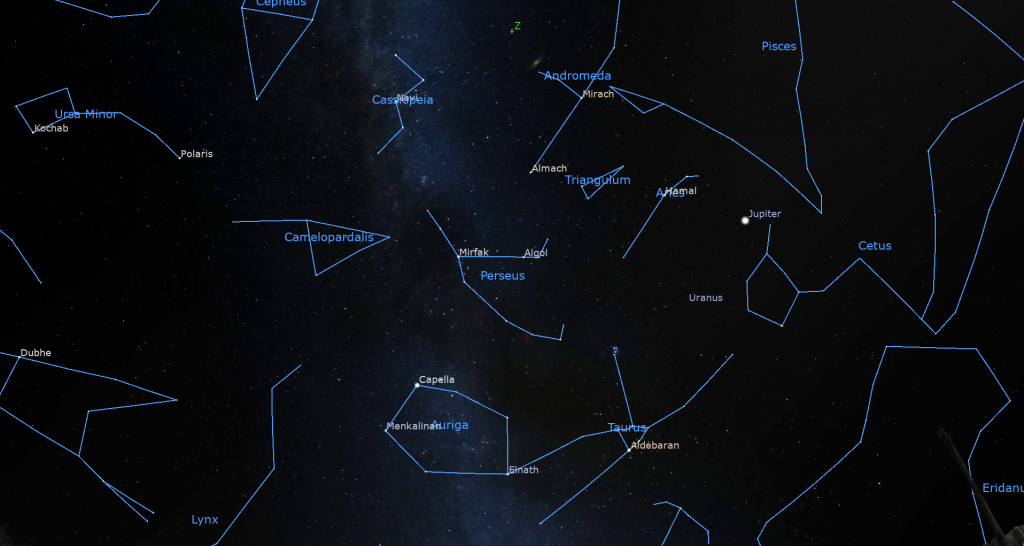
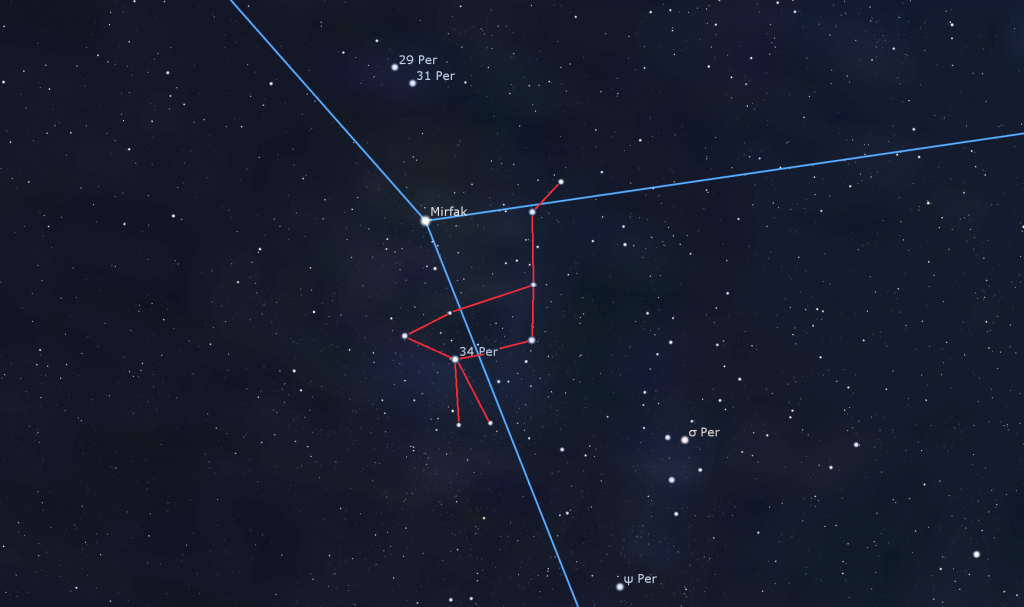
The Moon
The moon will continue to shine during the evening the world over this week. Tonight (Sunday and Christmas Eve), the bright, nearly full moon will shine among the stars of Taurus (the Bull). It will also be unusually high in the sky around 11 pm local time. December 24 is only three days past the solstice, when the noontime ecliptic was at its lowest height in the sky for the year and the nighttime ecliptic at its highest. On top of that, the moon’s orbit is inclined by 5° from the ecliptic, allowing the moon to wander by up to that amount below or above the ecliptic in the sky. Tonight it will be 3.5° or several finger widths higher than the ecliptic when the moon reaches its highest point (or culminates) a short time before 11 pm local time, giving “a lustre of midday to objects below”, to quote Clement Clarke Moore.
As I mentioned last week here, the bright moon will trek across the stars forming the upper half of the big Winter Hexagon asterism from tonight until Wednesday, as it will do every month until April.
On Monday, December 25, the moon will shine near the bright star Elnath, the star that marks the upper horn tip of the bull and also completes the ring-like form of Auriga (the Charioteer). Astronomers have formally assigned every star in the sky to a specific constellation, much like the cities and towns within a country. But a few stars are informally used as part of a next-door constellation. The bright star Alpheratz or Alpha Andromedae, which shines high in the western sky every night nowadays, serves to mark the head of the princess and also one corner of the Great Square of Pegasus.
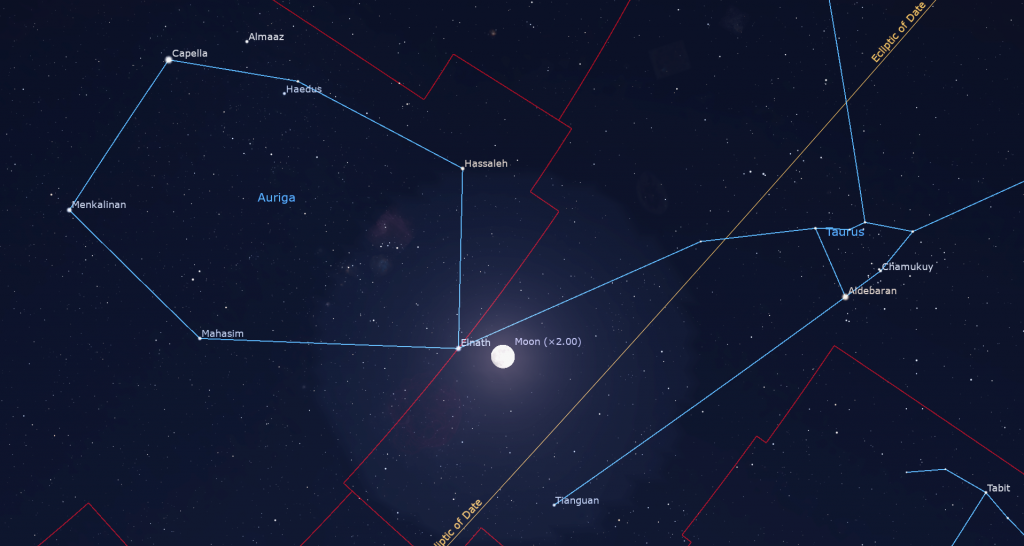
The moon becomes fully illuminated when it is opposite the sun in the sky. It rises at sunset and sets at sunrise. Full moons during the winter months climb as high in the sky at midnight as the summer noonday sun, and cast similar shadows. The December full moon will occur at 7:33 pm EST or 4:33 pm PST on Tuesday, December 26 in the Americas. That converts to 00:33 Greenwich Mean Time on Wednesday, December 27. Traditionally known as the Oak Moon, Cold Moon, and Long Nights Moon, it always shines in or near the stars of Taurus and Gemini (the Twins). The name Moon Before Yule is given to the last full moon of the year. But this year, that event won’t happen before Christmas. Full moons at Christmas aren’t rarer than a full moon on any other date of the year. The next full moon on Christmas will occur in 2034.
Indigenous groups have their own names for full moons, which marked time and lit the way of hunters and travelers at night before modern conveniences like flashlights. Unlike our regulated western calendar, they often name the full moon to reflect what is happening in the environment around them. The Ojibwe of the Great Lakes region call the December full moon Manidoo Giizisoons, the “Little Spirit Moon”. For them it is a time of purification and of healing of all Creation. The Woodland Cree of the Central Canada call the December moon Thithikopiwipisim, the “Hoar Frost Moon”, when frost sticks to leaves and other things outside.
For the rest of this week the moon will rise nearly an hour later each night, wane in illuminated phase, and linger longer into the morning daylight. It will spend Wednesday near the “twin” stars Castor and Pollux, the brightest stars of Gemini. For Thursday and Friday, the moon will outshine the faint stars of Cancer (the Crab) that surround it. The moon will end the week beginning a trip through Leo (the Lion). Early risers can see it in the western sky, a counterpart to bright Venus over in the east.
The Planets
Speaking of Venus, the brilliant planet continues to dazzle us in the southeastern sky every morning between the time when it rises, around 4 am, and sunrise. Over the next couple of months, the planet will drop a little lower each morning as its orbit returns it sunward. If you head out for a look before the sky brightens on a few mornings this week, you can detect Venus’ motion across the stars of Libra (the Scales). Over the next few days binoculars will show the golden star named Zubenelhakrabi shining to Venus’ upper left (celestial north). Viewed through a telescope this week, our next-door planet will show a shrinking, waxing gibbous disk spanning 14.9 arc-seconds.
Zubenelhakrabi means “Claws of the Scorpion”. Although the Babylonians had envisioned it, plus the bright stars Zubeneschamali, Zubenelgenubi, and Brachium as balance scales, the Greek and Arab astronomers used them as the outstretched claws of a great scorpion. The ancient Romans created the modern constellation of Libra by clipping off the claws of Scorpius, but the original stars’ names have been retained. The Arabic word zuben means “claw”.
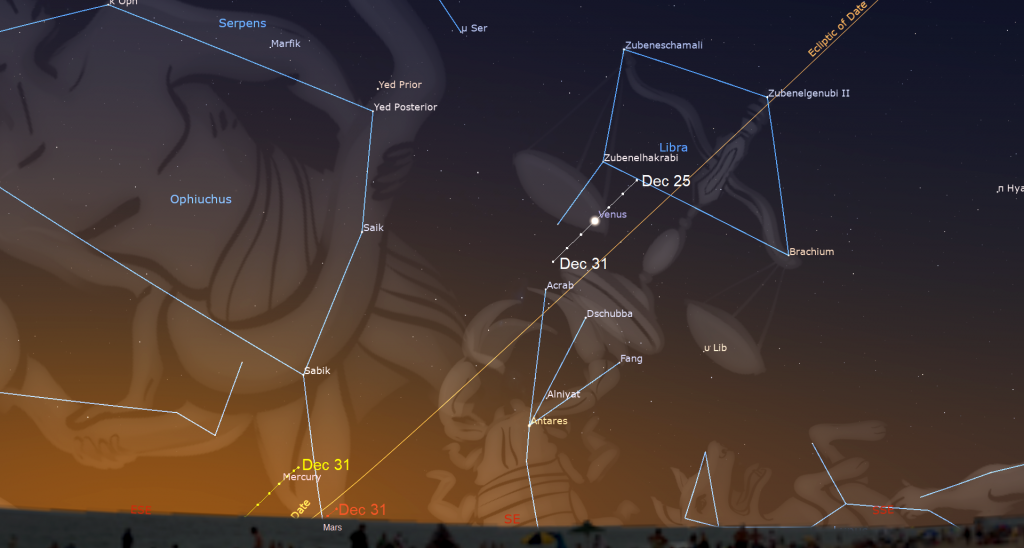
Mercury and Mars have both passed the sun and entered the pre-dawn sky, but they are hidden within the morning twilight. Towards the end of this week Mercury will have stretched far enough from the sun to be spotted with difficulty. It will improve until mid-January. Mercury will pass several degrees above somewhat fainter Mars on Thursday morning. Observers living near the tropics might see the pair side by side around 5:30 am local time. For eye safety, turn all optics away from the eastern horizon before the sun rises.
The other planets are all available for viewing in the evening sky. While not observable, the dwarf planet Pluto is hanging out near the border between Sagittarius (the Archer) and Capricornus (the Sea-Goat). That part of the sky will be setting in the west after sunset.
Jupiter will be the first planet to appear as the sky darkens towards sunset. Its extremely bright, white dot will be easy to see in the southeastern sky and will make a terrific target for your new telescope! Even binoculars will show you Jupiter’s four Galilean moons in a line flanking the planet. Named Io, Europa, Ganymede, and Callisto in order of their orbital distance from Jupiter, those moons complete orbits of the planet every 1.7, 3.6, 7.2, and 16.7 days, respectively. If you see fewer than four moons, then one or more of them is crossing in front of or behind Jupiter, or hiding in Jupiter’s dark shadow – or two of the moons are very close together or occulting one another. All four moons will be huddling to Jupiter’s right tonight (Sunday) and Friday.
Jupiter will be rising in mid-afternoon. The planet will climb to a position relatively high in the southern sky around 8 pm local time and then set in the west by about 3 am. The two brightest stars of Aries (the Ram) named Hamal and Sheratan, will shine a generous fist’s diameter above Jupiter. The stars forming the Great Square of Pegasus will be higher and to the right. The bright moon way over in the east might hide many of the stars.
Any small, decent quality telescope can show you Jupiter’s dark belts and light zones, which are aligned parallel to its equator. With a better grade of optics, Jupiter’s Great Red Spot, a cyclonic storm that has raged for hundreds of years, is visible for several hours when it crosses the planet every 2nd or 3rd night. For observers in the Americas, the GRS will cross Jupiter’s disk in mid-evening Eastern Time on Tuesday, Thursday, and next Sunday. It’ll appear late on Monday, Thursday, and Saturday night, and also during the wee hours of Tuesday, Thursday, and Saturday morning. The spot has been rather pale pink for some time now. If you have any coloured filters or nebula filters for your telescope, try enhancing the spot with them.
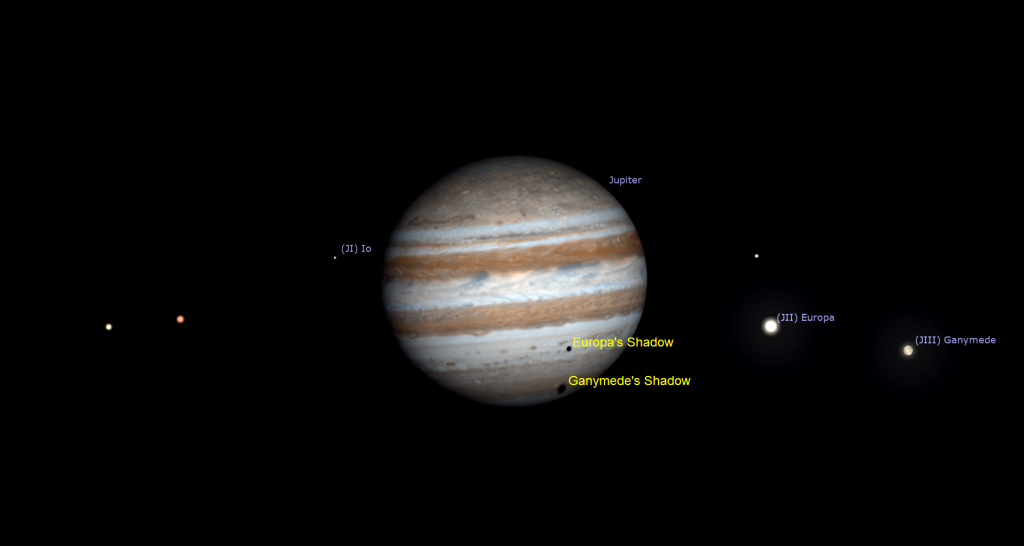
From time to time, the small, round, black shadows cast by Jupiter’s Galilean moons become visible in amateur telescopes when they cross (or transit) the planet’s disk. For those in westerly time zones of the Americas Io’s shadow will cross Jupiter on Thursday, December 28 from 12:23 to 2:30 am CST (or 06:23 to 08:30 GMT). Io’s shadow will cross again on Friday, December 29 from 7:54 to 10 pm EST (or 00:54 to 03:54 GMT on December 30).
On Saturday evening, December 30, telescope-owners in eastern USA and Canada, eastern South America, and the United Kingdom, Europe, and Africa can watch the shadows of both Europa and Ganymede cross the southern hemisphere of Jupiter at the same time for almost two hours. At 5:17 pm EST, the large shadow of Ganymede will join the smaller shadow of Europa, which began its own crossing of the planet 15 minutes earlier. Ganymede’s shadow will leave Jupiter at 6:53 pm EST, leaving Europa’s shadow to continue on alone until 7:18 pm EST. Don’t put your gear away yet! At 7:18 pm EST, Io will pop into view when it emerges from within Jupiter’s shadow, the end of an eclipse of that moon. (These times may vary by a few minutes, and other time zones of the world will have their own crossings.)
Next Sunday, December 31, Jupiter will temporarily cease its motion through the distant stars of southern Aries (the Ram) when it ends a westward retrograde loop that it began in early September. In the coming weeks the planet will ramp up to its regular eastward motion, which will carry it into Taurus (the Bull) for 2024. Retrograde loops occur when Earth, on a faster orbit closer to the sun, passes more distant solar system objects “on the inside track”, making them appear to move backwards across the stars for a period of time. Jupiter’s loop spanned about a fist’s diameter or 10 degrees along the ecliptic.
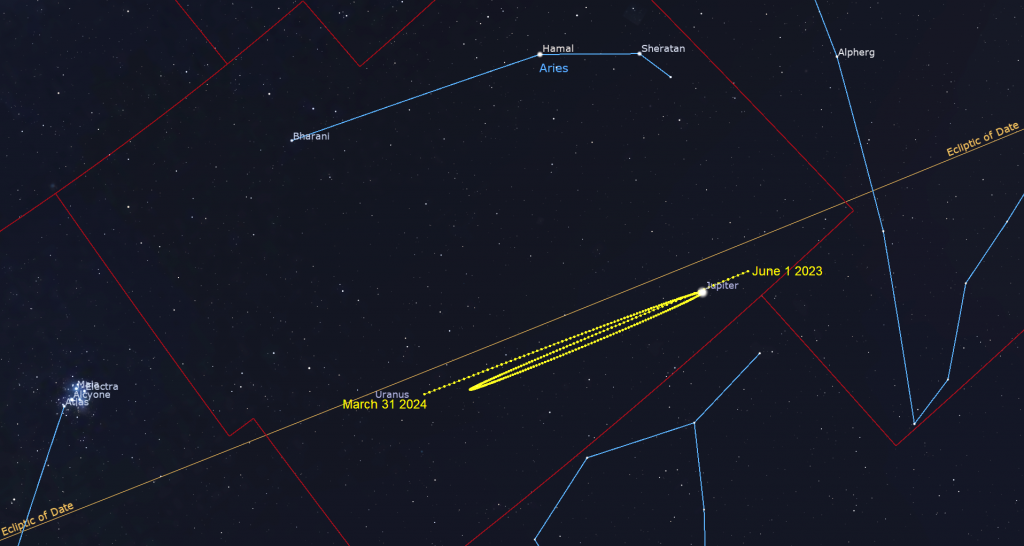
The early sunsets are allowing us to continue to enjoy views of Saturn every night, even though it is being carried inexorably sunward. Its creamy-coloured dot will pop into view partway up the darkening south-southwestern sky. That will be its best telescope viewing time. The the planet will sink westward to set around 9:30 pm local time. After dusk, the modest stars of Aquarius (the Water-Bearer) will appear sprinkled to Saturn’s upper left (or celestial east).
Powerful binoculars can show that Saturn has rings, but any size, style, or brand of telescope will let you see them easily. From Earth, Saturn’s axial tilt of 26.7° is letting us see the top of its ring plane, and allowing its brighter moons to array themselves above, below, and to either side the planet. Saturn’s largest and brightest moon Titan never wanders more than five times the width of Saturn’s rings from the planet. The much fainter moon named Iapetus can stray up to twelve times the ring width during its 80-day orbit of Saturn. The next brightest moons Rhea, Dione, Tethys, Enceladus, and Mimas all stay within one ring-width of Saturn.
During this week, Titan will migrate counter-clockwise around Saturn, moving from the lower right of Saturn (or celestial west) tonight, crossing closely above Saturn on Thursday-Friday, and then to the upper left of the planet (or celestial east) next Sunday night. (Remember that your telescope will probably flip the view around.) The rest of the moons will be tiny specks. You may be surprised at how many of them you can see through your telescope if you look closely.
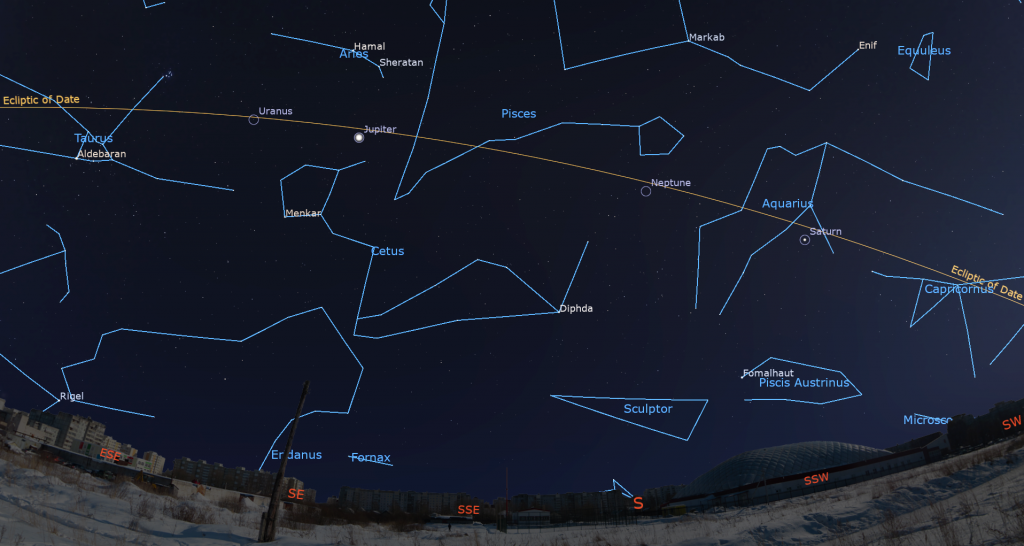
The bright gas giant planets Jupiter and Saturn are each being followed across the sky by a faint ice giant planet. This week Neptune will be located 2.2 fist diameters to Saturn’s upper left, or 22° to its celestial east-northeast. Neptune is located near the border between Aquarius and Pisces (the Fishes). On moonless evenings in December the magnitude 7.9 planet can be observed in good binoculars and backyard telescopes. Place Lambda Piscium and Kappa Piscium, the lowest two stars of the circlet of Pisces, just outside the top right of your binoculars’ field of view and look for blue Neptune near the lower left edge of the field. Or, search less than a binoculars’ field width to the right (or celestial west) of the box formed by the four medium-bright stars 27, 29, 30, and 33 Piscium. Try to look at Neptune as soon as it gets dark, while the planet is higher and appears crisper in your telescope.
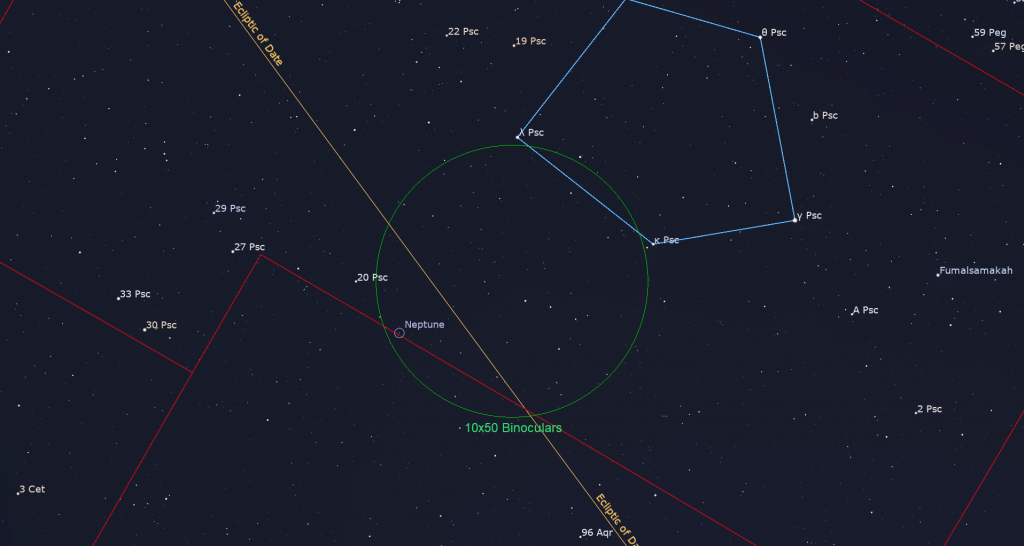
Over in the southeastern sky, the blue-green planet Uranus will be positioned 1.4 fist diameters to Jupiter’s left (or 13.9° to the celestial ENE) in southeastern Aries and available for viewing all night long. The bright Pleiades star cluster will also be located a generous fist’s width to Uranus’ upper left (or 11° to its celestial northeast). Magnitude 5.7 Uranus is normally quite easy to see in binoculars and backyard telescopes – some people have even been able to spot the planet with their unaided eyes. Hold off a few nights to allow the bright moon leave the sky. Use binoculars to find the medium-bright star Botein between Jupiter and the Pleiades. Uranus will appear several finger widths to its lower right.
Public Astronomy-Themed Events
Every Monday evening, York University’s Allan I. Carswell Observatory runs an online star party – broadcasting views from four telescopes/cameras, answering viewer questions, and taking requests! Details are here. They host in-person viewing on the first clear Wednesday night each month. Other Wednesdays they stream views online via the observatory YouTube channel. Details are here.
Keep your eyes on the skies! I love getting questions and requests. Send me some!